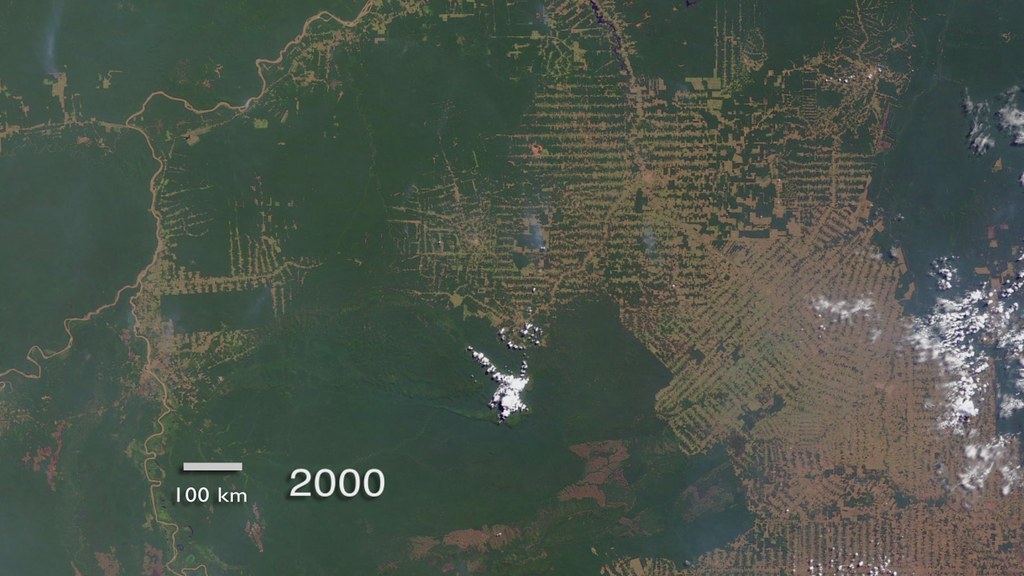October 2, 2015
Air Date: October 2, 2015
FULL SHOW
SEGMENTS

Shell Oil Backs Down
View the page for this story
After a multibillion dollar investment in exploratory drilling,a combination low oil prices, public pressures and a disappointing amount of yield from a test well have led Royal Dutch Shell to abandon its Arctic drilling plans. Executive Director and Founder of Oil Change International Steve Kretzmann tells host Steve Curwood why Shel was frozen out and the prospects for other new oil and gas development around the world. (07:15)
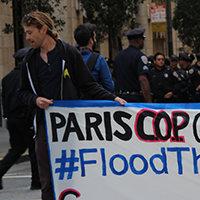
The Pathway to Paris
View the page for this story
The UN’s Paris climate summit is only two months away, and nearly all of countries have submitted their plans for emissions reductions. Jennifer Morgan of the World Resources Institute discusses with host Steve Curwood where we stand heading into the conference, and the likelihood of getting a strong deal to protect the planet. (06:45)
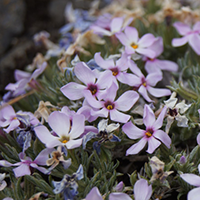
Invasives Threaten Native Grasslands in the Pacific Northwest
/ Courtney FlattView the page for this story
The Blue Mountains in Washington State are home to some rare wildflowers and grasses, but as Courtney Flatt of the public media collaborative EarthFix reports, invasive plant species are threatening to take over this delicate ecosystem. (04:10)

Beyond the Headlines
/ Peter DykstraView the page for this story
In this week’s trip beyond the headlines, Peter Dykstra tells host Steve Curwood how the withdrawal of Big Oil from the arctic has a small Canadian village torn between its traditions and income, and how language on climate change is hotly disputed just as often as the issue itself. And we mark the 45th anniversary of Nixon’s creation of the National Oceanic and Atmospheric Administration and the Environmental Protection Agency. (04:50)
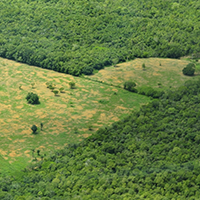
Amazon Tribe Fights Back Against Illegal Logging
View the page for this story
The Ka’apor tribe of Maranhao, Brazil depends on the Amazon rainforest for its livelihood, but illegal logging threatens to raze what little forest remains. Guardian correspondent Jonathan Watts tells host Steve Curwood about the situation and how the tribe is using both traditional and high-tech methods to defend its trees. (08:40)
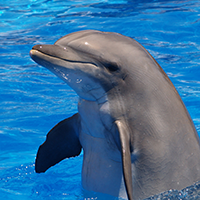
Humans and Dolphins
View the page for this story
Dolphins have fascinated humans for thousands of years, inspiring art, scientific study, and a yearning to keep them close. They’re the subject of Susan Casey’s new book ‘Voices in the Ocean’,and she discusses with host Steve Curwood what’s remarkable and troubling about the ways we sometimes interact with and affect dolphin species. (13:25)
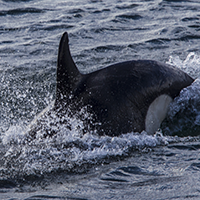
Black Lightning
/ Mark Seth LenderView the page for this story
The icy tide swells, and herring follow the turbulent waters into Iceland’s western fjords. On a grey day, writer Mark Seth Lender observed as a pod of Orca follows and feasts on the fish. (02:30)
Show Credits and Funders
Show Transcript
HOST: Steve Curwood
GUESTS: Steve Kretzmann, Jennifer Morgan, Jonathan Watts, Susan Casey
REPORTERS: Courtney Flatt, Peter Dykstra, Mark Seth Lender
CURWOOD: From Public Radio International, this is Living on Earth.
[THEME]
CURWOOD: I'm Steve Curwood. Shell writes off billions of dollars of investment in the Arctic – but that might not be the worst cost to the company.
KRETZMANN: I think that people around the world, really, correctly saw that Shell was pursuing profit over concerns about the environment here, and I think that that is a huge reputational risk to Shell.
Shell pulls out of the Arctic – and we assess the prospects for drilling elsewhere in costly locations. Also — it can be tough to protect native grasslands out west from some deadly invasive species ..
DARRACH: I call it holocaust grass because it’s an ecological holocaust potentially in the making. This grass can actually kill cheat grass, and that is a superman grass if you ask me.
Killer grasses and more this week, on Living on Earth – Stick Around!
[NEWSBREAK MUSIC: Boards Of Canada “Zoetrope” from “In A Beautiful Place Out In The Country” (Warp Records 2000)]
ANNOUNCER: Support for Living on Earth comes from United Technologies, innovating to make the world a better, more sustainable, place to live.
Shell Oil Backs Down
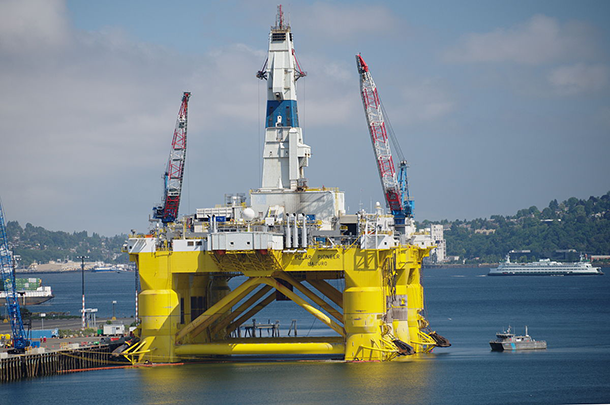
Royal Dutch Shell Polar Pioneer ("IMO 8754140") is a semi-submersible offshore drillship at the Port of Seattle Terminal 5 (Photo: Dennis Bratland, CC BY-SA 4.0)
CURWOOD: From the Jennifer and Ted Stanley Studios at the University of Massachusetts Boston and PRI, this is Living on Earth. I’m Steve Curwood.
Market conditions, and the challenge of operating in the Arctic, have done what simple appeals for conservation could not: Royal Dutch Shell has given up its pricey attempt to drill oil wells in the Chukchi Sea off Alaska. The drilling was widely condemned by conservationists and many Native Alaskans – but also welcomed by some as a source of income. Shell spent the summer probing for oil and natural gas and hoped to tap 26 billion barrels of supposedly recoverable oil — but, despite all the cash, they came up empty. Steve Kretzmann is Executive Director and Founder of Oil Change International and joins us now. Welcome!
KRETZMANN: Thanks so much for having me again, Steve.
CURWOOD: How did Shell get it so wrong? Why didn’t they find something worthwhile?
KRETZMANN: You know, any big exploration for a big new field like they’re engaged in is always a bit of a gamble. And Shell put themselves in a situation where they were trying to draw an inside straight and they didn’t get it, and so they’ve backed off at this point. But, you know, they raised the stakes at that table tremendously by all the controversy that was caused in the fact that they were going into such a pristine environment and the fact that climate activists have really locked on to Arctic drilling as something that is completely incompatible with climate-safe future. So, they didn’t have a lot of margin for error. They were concerned about what they called the ‘challenging regulatory environment,’ going forward, and you know, where Shell says ‘challenging regulatory environment,’ I say ‘kayaktivists and friends and heroes’, I think that citizen pressure really made a hug difference here, and pretty much made this a foregone conclusion for Shell.
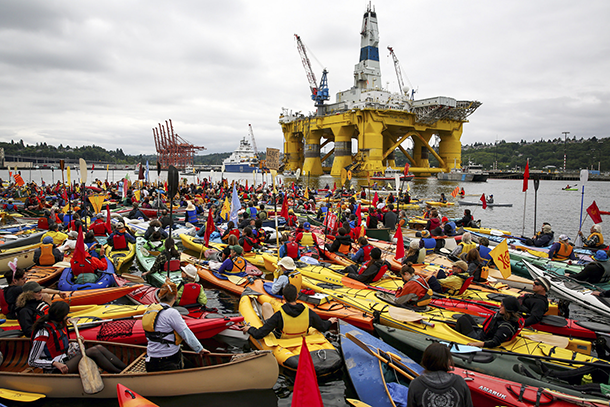
Activists who oppose Royal Dutch Shell's plans to drill for oil in the Arctic Ocean prepare their kayaks for the "Paddle in Seattle" protest on Saturday, May 16, 2015, in Seattle. (Daniella Beccaria/seattlepi.com via AP)
CURWOOD: By the way, how much did Shell invest in this—what will now be known as Shell’s folly?
KRETZMANN: Somewhere between seven and nine billion, that’s the range of estimates that I’ve seen—and that’s a really, really impressive number. Although, it’s probably worth noting that much of that, if not all of that, can be written off because of, you know, generous tax deductions for exploration in the United States, and particularly in Alaska.
One of the subsidies that the oil industry has is the Intangible Drilling tax credit, which allows them to deduct pretty much everything associated with the exploration well, except for the actual well itself. And so, in this case, that includes ships and helicopters and an entire fleet of support vessels. So, it’s really the taxpayers who are going to be on the hook for this, like we are for so much of the oil industry activity around the world.
CURWOOD: Steve, remind us of where Shell was trying to drill in the Arctic, and what was at risk environmentally there.
KRETZMANN: So, Shell was trying to drill in the Chukchi Sea, about 150 miles offshore of the North Slope of Alaska. It’s a very unique environment, and a very fragile environment. People were obviously very, very concerned about what a spill a la the Deepwater Horizon would have meant up there and it’s critical walrus habitat, polar bear habitat, obviously, and there’s just a tremendous stress from climate change, and so people were really worried that opening up the Arctic for this kind of industrial activity is exactly the wrong direction to go if you are concerned about climate change.
CURWOOD: So, who’s left drilling the Arctic? The Norwegians? The Russians?
KRETZMANN: Yeah, both the Norwegians and the Russians are somewhat active in the Arctic, although the low oil price has really depressed activity in all the sort of extreme exploration areas where you have high cost wells, high carbon wells—that was seen, just a few years ago, as the big next growth area for the oil industry, but now, it’s looking more and more doubtful. In Norway, you have the Italian oil company Eni that is in its final phases of bringing on a big new rig they call Goliath. But it is much closer to shore than the Shell rig would have been, and it’s quite controversial in Norway. Norway is a country that just divested from coal, they’re very concerned about climate change and there’s campaign activity ongoing there to try to stop Eni from starting, which they would do very soon.
CURWOOD: The Russians?
KRETZMANN: Yeah, the Russians have one big rig that they’ve been working on. But they haven’t found much, and the sanctions for the Russian invasion of Ukraine has really bit into the Russians’ ability to really explore the Arctic at this point. And, they seem to be sort of back-burnering those projects at the moment.
CURWOOD: What about onshore in the Arctic? I’m thinking of ANWR [the Arctic National Wildlife Refuge], the National Petroleum Reserve there… what are the prospects for more drilling there?

Peaceful protest against Shell’s Arctic drilling in Bellingham, Washington. (Photo: Robert Ashworth, CC BY 2.0)
KRETZMANN: Similar in this price environment. It’s still a long ways away. The break even price point is better onshore than it is offshore, for sure, you have to spend less money to get it. But, it’s also very far from market. They have to spend a lot of money to try to get it down to the lower 48 or export it somewhere else to another country. And so, it doesn’t look that good for them up there either.
CURWOOD: Now, what about the other offshore drilling plans that the Obama Administration approved—some leases off of Florida and the North Atlantic coast? Which of those are a go for actual drilling, do you think?
KRETZMANN: Well, I don’t think we’re at that stage yet. The Obama Administration has announced that they plan to sell leases off the Atlantic and off the Arctic next year. So, that is going to be where the environmental community begins to dig in in response to this.
CURWOOD: Now, what happened to Brazil’s plans to go for oil in the deep ocean off their coast—in the South Atlantic?
KRETZMANN: Yeah, they’re still planning to do it. The pre-salt formation is something that they are pursuing. But, again, the current price environment is very bad for them. That’s an expensive proposition, just like Arctic oil is. Plus, the Brazilian oil company, Petrobras, has been embroiled in a corruption scandal. And, so, there’s a lot of uncertainty over those projects right now.

Steve Kretzmann is the Founder and Executive Director of Oil Change International. (Photo: courtesy of Mr. Kretzmann)
CURWOOD: By the way Steve, you keep mentioning the price of oil as being a huge disincentive for drilling in exotic places like the Arctic or the deep, deep ocean. And, of course, the Saudis and especially the other Gulf oil states have been pumping like crazy. To what extent do you think their decision to produce heavily is actually having an environmental benefit?
KRETZMANN: You know, I think that they’re definitely whether intentionally or not, keeping a lot of the highest cost, highest carbon resources off the market at the moment. And so, they’re making it very difficult for the Western oil industry to be profitable in looking for other oil. The good news there is, as climate science tells us, we have more than enough oil. If what this means is it’s that much more of a nudge for the oil industry to stop looking for more of something that we know we have too much of, that’s a good thing.
CURWOOD: Steve Kretzmann is Executive Director and Founder of Oil Change International. Thanks for taking the time with us today.
KRETZMANN: Thanks very much!
Related links:
- Royal Dutch Shell in the news and financial performance
- Royal Dutch Shell
- “Kayaktivists” hang from bridge, form floating platoon to protest Shell’s Arctic drilling activities
[MUSIC: Thomas Newman, “Raining Oil,” Jarhead soundtrack, Decca 2005]
The Pathway to Paris
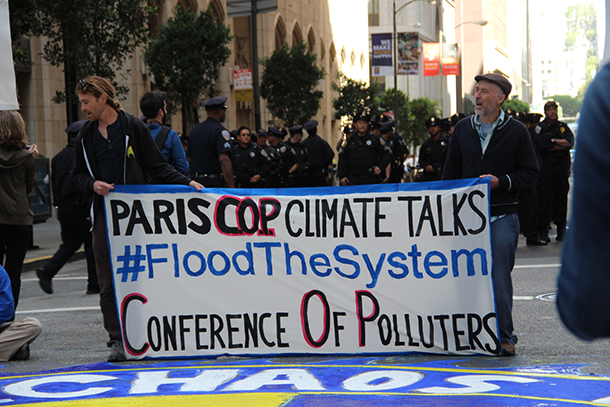
Some protesters feel the Paris climate negotiations are polluted by fossil fuel interests. (Photo: Peg Hunter, Flickr CC BY-NC 2.0)
CURWOOD: September saw climate at the top of the international agenda, with the Pope and other heads of state and government at the UN pledging action in advance of the Paris Climate Summit later this fall. China, the biggest emitter of global warming gases, announced it will soon begin a nationwide cap and trade program and partner with the United States, the world’s second biggest emitter, to reduce emissions together. Jennifer Morgan is the director of the Climate Change program at the World Resources Institute, and she joins us now to discuss the China deal and the pathway to Paris. Welcome back to Living on Earth, Jennifer.
MORGAN: Thanks, great to be here.
CURWOOD: So how big a deal, how significant is this US—China accord on the climate?
MORGAN: Well, I think it’s a really big deal, because we had the first one last November — which was, I think, historic to have both of them coming out together — but now, to have something that's so detailed and for them to be coming together on core elements of the agreement itself, just shows that there is quite a lot of collaboration, and that they're both very committed to actually transforming their economies and getting a good agreement. So there's no hiding behind either of them anymore; the two largest polluters are moving. Each of them of course need to do more; but it's pretty unprecedented, this agreement.
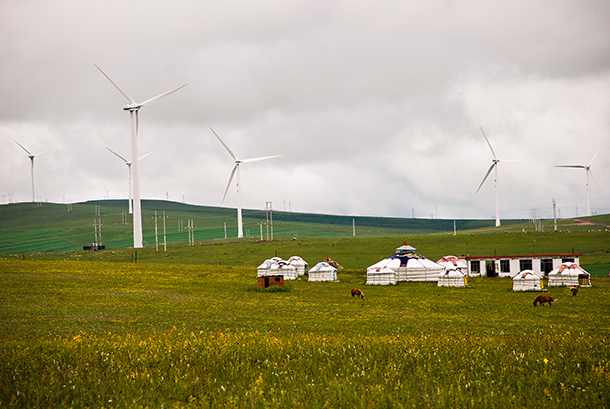
Windmills in China. China and the US reached an agreement in which the Chinese announced the launch of a national cap and trade program. (Photo: Asian Development Bank, CC BY-NC-ND 2.0)
CURWOOD: By the way, how ironic do you think it is that a communist country like China would be basing much of its climate action on a market-based solution like cap and trade, before the United States actually is able to do cap and trade, apparently?
MORGAN: It is pretty ironic. I think the fact that China is able to do this and put a price on carbon just shows how important it is. They have to build a lot of the systems to be able to put this in place, they have had their pilots, the US could do this much more quickly much more easily with the system that we have here. Hopefully it will raise some eyebrows, and actually not just raise eyebrows, but get some things moving in the US.
CURWOOD: How competitive are these two countries being in terms of ambition here?
MORGAN: Well, I think it is a really interesting comparison at this point in time, because if you look at what China put on the table for climate finance for developing countries, it was $3.1 billion, and the US last year put $3 billion. If you look at their national implementation plans, you really see China stepping forward. And this type of positive competition, I think, has definitely entered into the room, and that can only bleed over into other rooms as well.

Pope Francis’ recent visit to the United States shined the spotlight on climate change. (Photo: Department of Defense, public domain)
CURWOOD: So, in this next round of negotiations in Paris, there’s pledges of the emissions reductions ahead of the summit; how are those pledges going at this point?
MORGAN: So I think that, you know, stepping back, one of the first things to look at is the fact that there's so many countries that have come forward with these commitments. 75 have committed now, with, you know, around that amount of emissions covered; in the next few days I think you'll have almost all of the emissions in there. And I think that it's fair to say that they are pushing ambition further than it would have been, that they're more transparent so there can be more accountability than they could have been. But of course, they're more of a floor than a ceiling of the level of ambition of each country.
CURWOOD: So Jennifer, where do we stand now heading into those talks in Paris? How likely do you think there will be a deal with binding limits for everybody?
MORGAN: Well, I think that there is likely to be a deal. I think the question is the level of the ambition of that, and whether we’re talking about more than just a one-off deal but actually about a transformation, actually about a turning point, a new regime where countries are working together to reduce emissions, to adapt to the impacts, one that continues to send short-term and long-term signals so that you know there's no question anymore where you should invest your money. It's how fast it's happening.
CURWOOD: Now, the group Climate Interactive, which is at MIT, recently put out an analysis of the pledges that had been made by the countries so far, and found that they would reduce overall global warming to about, well, a little more than 6° Fahrenheit by the end of the century. That's a significant reduction from business as usual on the positive side, but at this point countries are saying, “wait, we really shouldn’t go over a little more than 3 1/2° of warming to avoid catastrophic impacts”. What you make of that analysis?
MORGAN: Well, I think the analysis is incredibly important and very helpful, because it both shows, you know, what's been catalyzed by the Paris moment, and that there has been significant new action catalyzed by the Paris agreement, but it also spells out how much more there is still to do. And it puts, therefore, an emphasis, in my view, on getting the agreement itself to make sure that there is a further acceleration of these types of commitments and reductions so that catastrophic climate change is avoidable.
CURWOOD: Some would say that even though this deal in Paris that seems to be moving forward would not keep warming to the below 3 1/2° or two degrees C, it still buys time for further negotiations and therefore is useful. Your feelings?
MORGAN: I think it has a chance of doing more than just buying time, and I think that one needs to look more — at more than just the math of these national plans to understand what's been set into motion. One needs to look at the scale up of renewables, one needs to look at the avoided lock-in of high carbon infrastructure that transports coal and oil. And if you bring that into the mix, and I think if the agreement is solid, you have a shot of still staying below two degrees, due to the Paris moment.
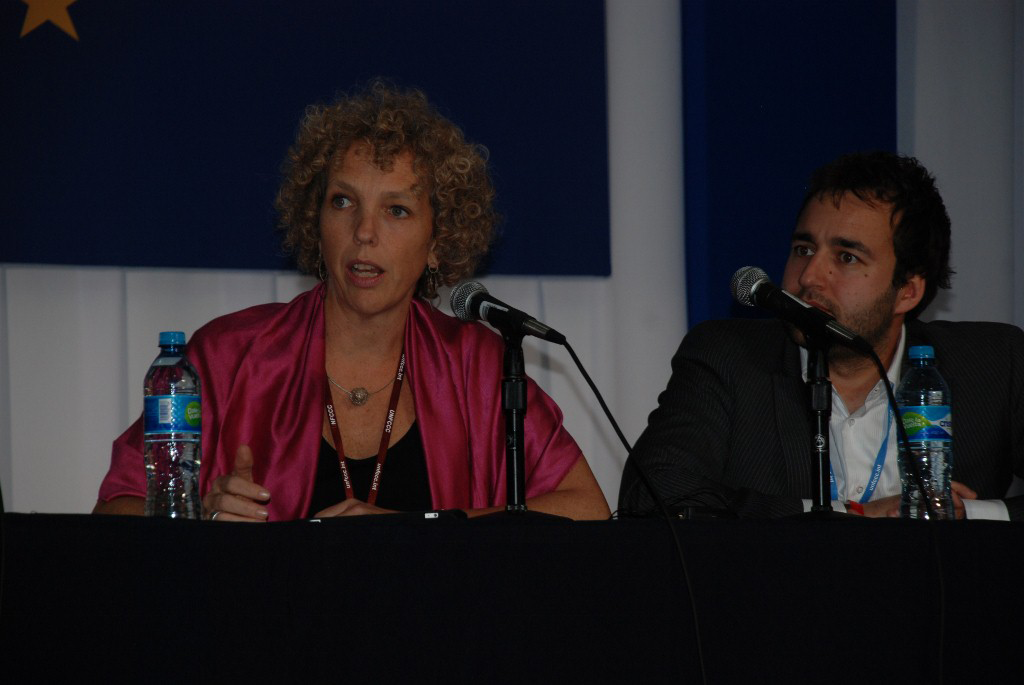
Jennifer Morgan at COP 16 in Cancun, Mexico in 2010 (Photo: World Resources Institute, CC BY-NC 2.0)
CURWOOD: Finally, Jennifer, the Pope’s recent visit to the United States Congress, the Whitehouse, the UN loomed large. And I’m just wondering how much you think he’s influenced the policy discussions at this important juncture for the planet about the question of global warming.
MORGAN: I think the Pope’s engagement on this issue has been just truly transformational of the debate. It puts all of this into what really matters to people, what really matters to societies, and hopefully gets people to step out of their lobbying boxes for a moment and think about their children, their next generations, and really what's at stake, and to take politics out of this for a minute because it shouldn't be about politics.
CURWOOD: Jennifer Morgan is the director of the climate change program of the World Resources Institute. Thanks so much for taking the time today, Jennifer.
MORGAN: Thank you!
Related links:
- Climate Interactive’s Climate Scoreboard
- Current pledges to reduce emissions
- World Resources Institute
- UN Climate Change Conference (COP21/CMP11)
- More about China’s cap-and-trade program
- Brazil pledges to cut carbon emissions 37% by 2025
- India Pledges to Cut Emissions Intensity to Help Fight Climate Change
[MUSIC: Manu Chao, Bongo Bong, Clandestino Arc 21, Virgin France 1988]
CURWOOD: Just ahead, how one Amazon tribe is defending its own land from illegal loggers --Stay tuned to Living on Earth.
[CUTAWAY MUSIC: Bill Frizell, Greg Leisz, Jenny Scheinman, Remember, The Intercontinentals, Nonesuch.]
Invasives Threaten Native Grasslands in the Pacific Northwest
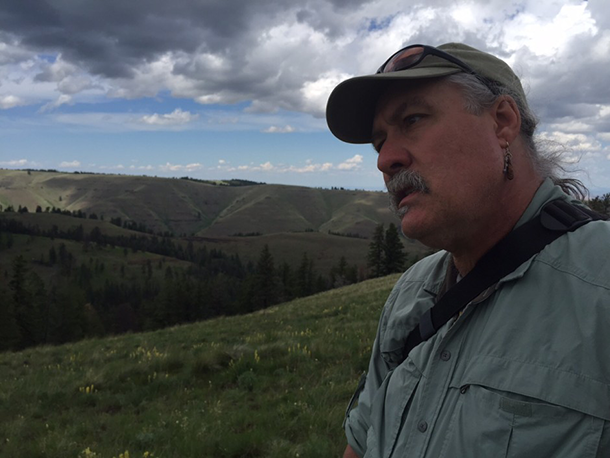
Botanist Mark Darrach has discovered three new plants on one hillside in the Blue Mountains. (Photo: Courtney Flatt, NWPR/EarthFix)
CURWOOD: It's Living on Earth, I'm Steve Curwood. Native grasses once blanketed the Palouse country of southeastern Washington state, though much of this hilly terrain now grows wheat. But there are still some native grasses, and in one grassland botanists have discovered several new flowering plants. And now scientists are worried that these rare plants could be in big trouble soon from invasive species. Courtney Flatt of the Public Media collaborative EarthFix has the story.
FLATT: On a hillside in Southeastern Washington, bunch grasses ripple in the wind. A storm is forming off in the distance, and crickets chirp nearby. It’s here that botanist Mark Darrach has found three rare flowers, flowers previously unknown to science. That’s a lot. He says many botanists are lucky to find one in their career.
DARRACH: It’s a unique plant community that hasn’t been recognized until just a couple years ago when we stumbled across these and started scratching our heads, like ‘Where did this come from? We’ve never seen this before.’
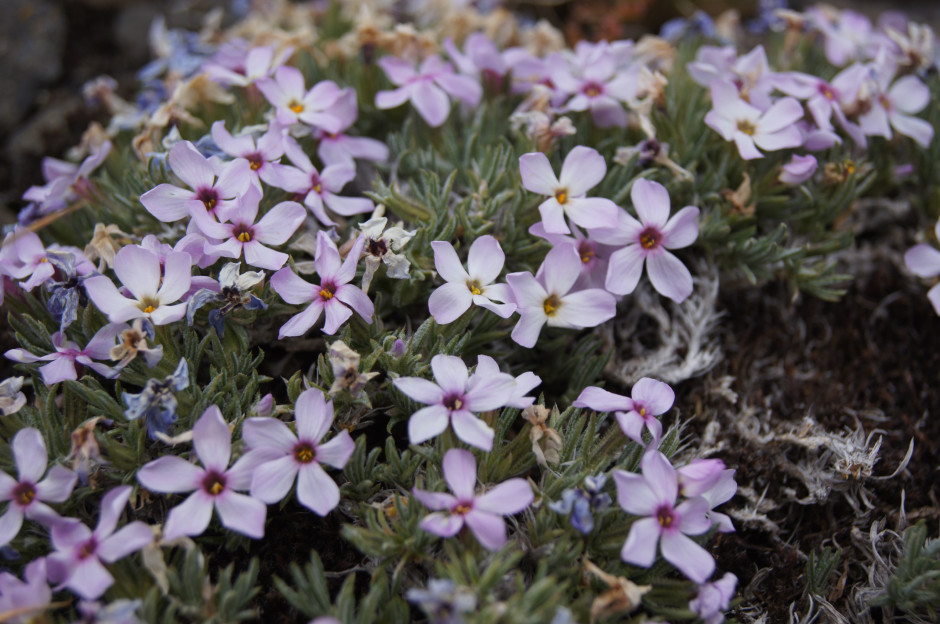
Mark Darrach identified this flower he calls Yeti Phlox. (Photo: Mark Darrach)
FLATT: One is a small, pink, star-shaped flower that springs up along the hillside’s peak. Darrach calls it Yeti Phlox. It’s covered in a hair-like fuzz. But just this season, Darrach has spotted a particularly nasty invasive grass gaining a foothold in the otherwise pristine grassland. The weed is called Ventenata grass. Darrach has another name for it.
DARRACH: I call it holocaust grass because it’s an ecological holocaust potentially in the making. This grass actually can kill cheat grass, and that is a superman grass if you ask me.
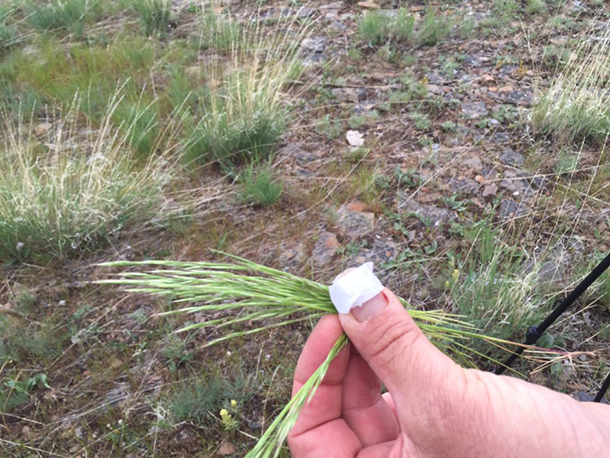
Mark Darrach holds up an invasive species called ventenata grass (Photo: Courtney Flatt, NWPR/EarthFix)
FLATT: Or maybe a super villain grass. It uses toxic fungus to poison other plants around it. That gives the weed a leg up to continue its takeover. To many conservationists, the type of grassland on this hillside — canyon grassland — is extremely threatened already. Most grasslands worldwide are not very intact. Take, for example, Washington’s Palouse.
KELLY: The Palouse prairie was once covered with native bunch grasses. But that area has largely been converted to agriculture a long time ago.
FLATT: That’s Brian Kelly. He’s with the Hells Canyon Preservation Council. He says the remaining native grasslands are dwindling. And they need to be preserved. Kelly says these grasslands form a mosaic with higher elevation forests.
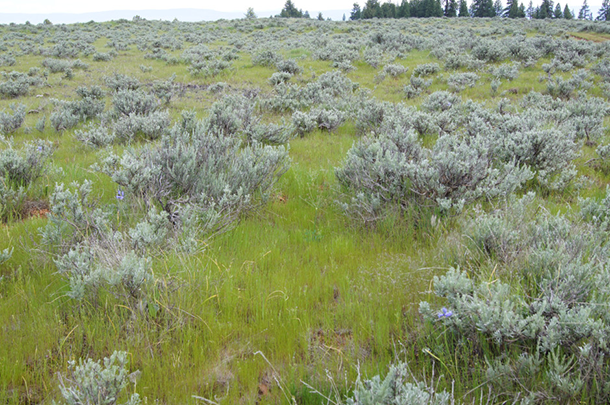
Ventenata grass takes over scrublands like this one (Photo: Mark Darrach)
KELLY: They create some really unique habitat and gives a variety of different animals and birds opportunities to utilize both habitats.
FLATT: It’s good habitat for a diverse variety of species -- from butterflies to mule deer to elk. Kelly says these grasslands are threatened by invasive species, overgrazing, off-road vehicles, and climate change.
Darrach isn’t 100 percent sure what brought the weed here. It’s common for invasive grasses to take root where cattle are allowed to trample the soil. But this is a place where cattle rarely roam. It’s too remote. Darrach says it’s possible the growing presence of elk that winter here are creating the same impacts that are often blamed on livestock.
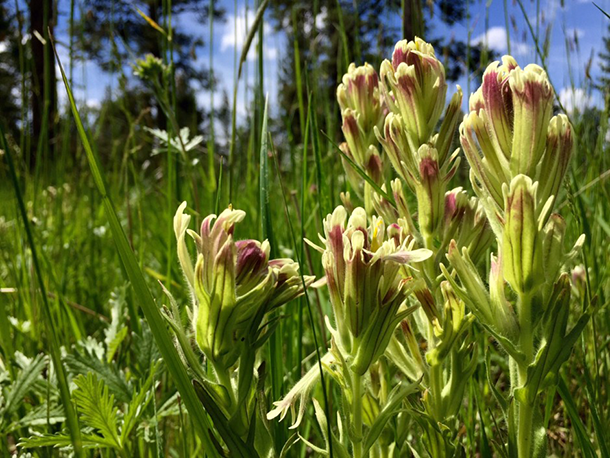
A rare species of paintbrush found by Mark Darrach. (Photo: Courtney Flatt, NWPR/EarthFix)
He’s certain about one thing, though: He doesn’t like the sight of this invasive grass.
DARRACH: All that real pale, green color is all Ventenata grass. Ugh. Enough to make a person want to head to the bar and drink a few.
FLATT: That’s why Darrach is worried for his newly discovered plants. What he calls his “vegetative children.”
DARRACH: You just shake your head and go, ‘Wow, I’m doing nothing but documenting the decline of biodiversity.’ I recognize these things as new species, but how do you come up with conservation strategies to keep the landscape intact?
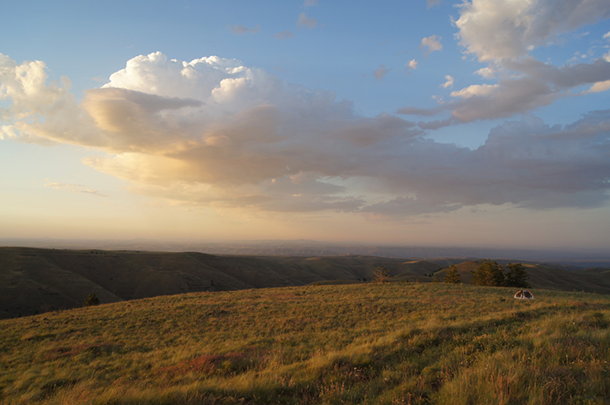
Canyon grasslands in the Northwest. (Photo: Mark Darrach)
FLATT: It’s a question that he’s yet to answer. He hopes raising awareness will help get ventenata grass listed as a noxious weed soon. That will give managers more power to fight its creep along hillsides like this. I’m Courtney Flatt in Asotin, Washington.
Related links:
- This piece was produced by the public radio collaborative, Earthfix
- Ventenata Grass
- MacFarlane’s four-o’clock
Beyond the Headlines

A melting pingo and polygon wedge ice near Tuktoyaktuk, Northwest Territories, Canada. (Photo: public domain)
CURWOOD: Now let’s visit the land down yonder beyond the headlines.
Peter Dykstra is on the line from Conyers, Georgia. He’s with EHN dot org, that’s Environmental Health News, and the DailyClimate dot org and has dug out some interesting nuggets to share. Hi there, Peter!
DYKSTRA: Hi Steve. Let’s start with a couple more observations on Arctic oil drilling. First, the retreat by Big Oil, not just in the Alaskan Arctic, but also in the Beaufort Sea off Canada, has a sort of a sad historic ring to it. Over a century ago, white Europeans and North Americans brought commercial whaling to the Arctic, with all sorts of implications for native culture, most of it not so good. Today, the potential for wealth and jobs, and the potential for disruption of both native traditions and the environment have Arctic communities split.
CURWOOD: And with both commercial whaling and oil drilling, an abrupt departure when the money picture changes.
DYKSTRA: Correct, and here’s another impact: A few hundred miles east of Shell’s proposed drillsite, the Beaufort Sea village of Tuktoyaktuk – everyone calls it “Tuk” for short – is far along on a massive building project – a permanent road to replace the seasonal ice road that connects Tuk to the rest of Canada. The village has tied its hopes to becoming an Arctic seaport, servicing the oil industry and merchant ships traveling through the melting Arctic Ocean. But even before Shell made its announcement, Exxon, BP, Imperial Oil, Chevron, and Statoil all announced that their Canadian drilling plans were on hold for at least five years, if not permanently. But the setback for Tuk’s economy may be a lifeline for its native traditions.
AP logo
CURWOOD: I suspect, though, it won’t heal the divisions in those native communities. What’s next?
DYKSTRA: I want to get in what I really hope is the last word on this media controversy over the use of the term “climate denier.” The Associated Press recently recommended dropping the use of the term “denier” in favor of “climate doubter,” or the mouthful of “one who rejects mainstream science on climate change.”
CURWOOD: Well, Peter, there are some people who “doubt” the evidence on climate change to be sure, but there are also people who say it’s all a hoax, right?
DYKSTRA: Yeah, and particularly for that group, here’s why I think the A.P. is wrong. Sigmund Freud and his wife Anna first brought the concept of denial into widespread use a century ago. To the Freuds, denial is a defense mechanism, and the accounts I read all describe it as a process of explaining problems away - like saying “The climate is always changing” or blaming others for problems (I’m looking at you, sunspots). Another marker of denial is not perceiving things that are obvious to others, like melting icecaps and acidifying oceans. And a third is rationalizing your own denial—saying things like “climate scientists are only in it for the money”, or that a snowstorm in one part of the world destroys decades of evidence of a warming planet. AP reporters like Seth Borenstein and Karl Ritter do world-class reporting on science and climate change, but on dropping an accurate word for squishier ones, the AP’s doing a disservice.
CURWOOD: Well, the quality and impact of AP reporting on climate change is something nobody can… Deny. Any last words on this?
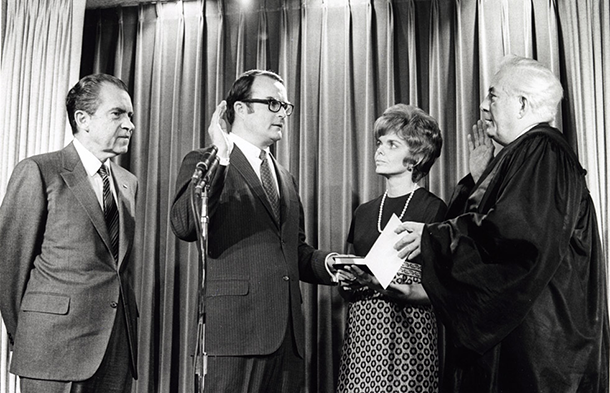
William D. Ruckelshaus sworn in as first EPA Administrator. (Photo: Nixon Presidential Library, public domain)
DYKSTRA: Yeah, DenierDenierDenierDenierDenier.
CURWOOD: OK, I probably should have seen that one coming. Alright Peter, let’s take our weekly journey into the world of environmental history. What have you got for us?
DYKSTRA: Long ago, in a faraway land, with two strokes of his pen, a President created two agencies that many members of his own party today want to abolish. Forty five years ago this week, on the second of October, 1970, Republican Richard Nixon authorized the creation of the Environmental Protection Agency, and on the third day, he created NOAA, the National Oceanic and Atmospheric Administration. The two agencies pulled together all sorts of science and environment functions that had been spread throughout the federal bureaucracy.
CURWOOD: But that hasn’t stopped a lot of people from complaining that EPA and NOAA have become bureaucracies unto themselves.
DYKSTRA: Well, sure, and with the possible exception of the IRS, there’s no government agency that makes more people mad every day than the EPA. Many in industry view EPA as an agent of tyranny, what with all this clean-air, clean-water talk. And environmentalists can get just as mad at EPA when things don’t get cleaned up – maybe like those thousand-plus Superfund sites still on the waiting list. And NOAA? If you want to see people get mad at NOAA, just go to a fishing town in the Gulf of Mexico or New England.
CURWOOD: So you’re saying it’s thankless work?
DYKSTRA: All too often it is. But think of where we’d be without NOAA – world-class research on oceans and climate change, and the one government product that virtually every one of us uses every day – the weather forecast. And without EPA, for all its flaws, like that little mine-waste accident this summer – we’d all just be driving around in our clean-burning Volkswagens, taking in the dubious substances dropped into our air and water. So thanks, bureaucrats, and happy 45th birthday to all of you.
CURWOOD: Peter Dykstra is with Environmental Health News, that’s EHN dot org, and the DailyClimate dot org – thanks Peter.
DYKSTRA: Alright Steve – thanks, we’ll talk to you soon.
Related links:
- AP Stylebook
- AP Stylebook boots term ‘climate change deniers’
- Denial as a defense mechanism
- Markers of denial
- NOAA’s anniversary
- EPA celebrates an anniversary too
CURWOOD: Hey, and there’s more on these stories at our website, loe dot org.
[MUSIC: Nick Drake, Pink Moon, Pink Moon, Island Music, 1972]
Amazon Tribe Fights Back Against Illegal Logging
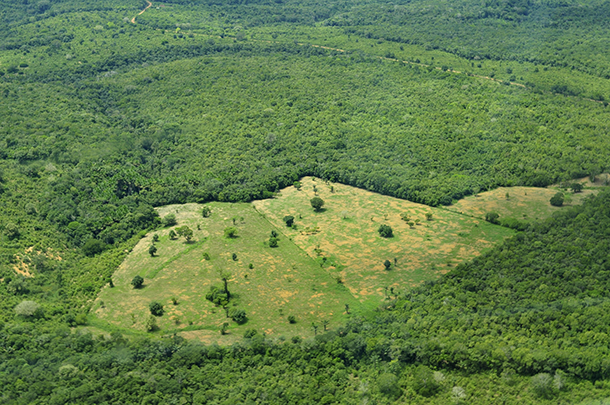
Approximately 17% of the Amazon rainforest has been lost in the last fifty years. (Photo: CIAT, Flickr CC BY-SA 2.0)
CURWOOD: A crucial part of the plan Brazil has announced to cap and reduce greenhouse gas emissions depends on halting illegal logging in the Amazon.
Illegal logging is highly lucrative, and despite steep penalties, authorities haven't been able to stop it altogether. In the Brazilian state of Maranhao, though, a local tribe is taking the protection of the forest into its own hands, and four of its leaders have been killed in the struggle. Jonathan Watts, Latin America correspondent for the Guardian, has been describing just how these indigenous people are defending their trees. Jon, welcome to Living on Earth!
WATTS: Hi Steve, good to be on the show!
CURWOOD: First of all, where is Maranhao?
WATTS: Maranhao is in the far North of Brazil. It’s the poorest state in the country, and it was, until about 40 or 50 years ago, quite a heavily forested area. But in recent decades it's been largely cleared for cropland and for grazing pastures.
CURWOOD: How legal is that, and what does that mean for the people who live there?
WATTS: All of the logging that now takes place is being done illegally. It greatly affects the livelihoods of the people in the forests, because the last remaining areas of forest are all in indigenous territory. It's the territory of the Ka’apor people. They are a tribe that has been there for many generations, and they say that when the trees are cut down they lose their livelihoods, because the trees are the source of many of the fruits that they eat, it’s where the birds they get their head-dresses from live, and it’s part of an ecosystem that they have grown used to living in for as long as anyone can remember.
CURWOOD: Now, Jon, what happens what an illegal logging crew shows up in the forest that the Ka’apor tribe is guarding?
WATTS: What happens when the Ka’apor find illegal loggers is that they deal with them very aggressively. They round up as many of their people as they can, they head out having painted their skin in basically war paint, they arm themselves with bows and arrows and heavy clubs, and then they surround the logging trucks. They force the loggers to come out, they disarm them if they have weapons, and then they warn them not to come into their forest. And if they find people that they have caught before, and warned before, they will strip them, beat them and they will drive them away. And in every case they burn the loggers’ trucks and tractors. So you see a very aggressive response to illegal logging.
CURWOOD: How does a bow and arrow take on, you know, an automatic weapon?
WATTS: Well, essentially it can’t. What the Ka’apor depend on is the fact that they tend to outnumber the loggers; and mostly the loggers — the people who actually do the logging — it’s not worth their while getting into a dangerous confrontation, and so they give up their arms. On the other hand, the big business people behind the illegal logging operations, they don't want to be kept out of the forest. The Ka’apor, as far as we know, have never killed anybody, they have broken some bones, but the loggers do appear to have responded with lethal force. That they have been hiring assassins to kill the Ka’apor tribe’s leaders, though it has to be said we don't know that for sure, because none of these killings have been investigated to the point where anyone is being prosecuted.
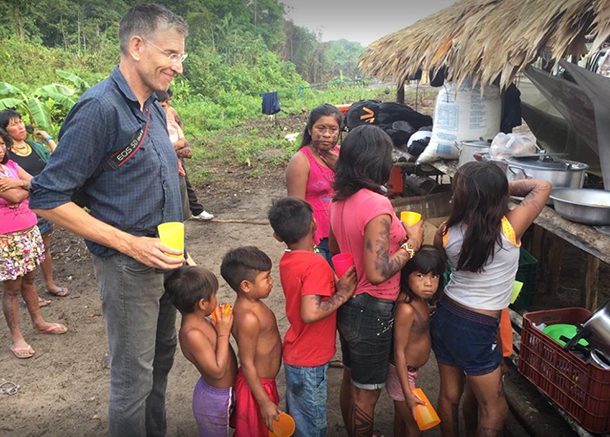
Watts queues up for breakfast with the local Ka’apor villagers. (Photo: courtesy of Jonathan Watts)
CURWOOD: So how does this tribe, the Ka’apor, in what ways do they use technology to protect their forest?
WATTS: The Ka’apor are at once a very traditional tribe, as I said; they use bows and arrows, they have face paint, they use head-dresses made from bird feathers, it looks like something out of a very old film when you are there, and yet at the same time they are very modern. They have had contact with the outside world for many generations. Many of their members can speak Portuguese, many of them can drive, some have motorbikes, and some can use computers. And they are now, with the help of Greenpeace, using even more advanced technology in their battle against the illegal loggers. As of last month, they took hold of more than 10 GPS tracking devices, and they tried to put those onto the logging trucks and trace where they’re going, so that they can get evidence to actually prosecute the people behind the loggers on the ground. They have also taken hold of a dozen camera traps -- they’re usually used for capturing images of rare wildlife, but in this case they are being set on the logging trails in and out of their forest, with the idea that they can catch one of the lorries going in empty and leaving with a full load of logs.
CURWOOD: And what about the local authorities; what are they doing to try to stop this illegal logging?
WATTS: Well, the Brazilian authorities - they have a mixed record when it comes to dealing with illegal logging. At a national level they're doing a lot of the right things. In recent years the government has allowed the establishment of wider indigenous territories, higher penalties are being imposed on illegal loggers, and a part of the environment agency called IBAMA has been working with the space agency to use sophisticated satellite imaging to find out which areas are being cleared and then to send armed rangers in helicopters or jeeps to try to catch people in the act and then prosecute them. And as a result of this, deforestation in Brazil has slowed quite dramatically in the last 10 years, but at the same time illegal logging continues and is often not seen by satellite devices. And it's also corrupt officials in government agencies that provide counterfeit documents that make it look like the illegally felled logs have actually being properly cleared and have the full authorization.
CURWOOD: What steps are being taken to stop this corruption, if any?
WATTS: The measures that are being taken against it are to increase penalties against those involved and in theory investigations by the police. This, however, has had mixed success. The problem is that the Amazon is so huge and so sparsely populated that in many cases in environment officials and federal police are trying to cover an area the size of a small country with just one of two men, and if they come up against large logging gangs or powerful businessmen they are just outnumbered and often outgunned. And so, more often than not, environmental criminals get away with this sort of thing, and it's estimated that something like 80% of the wood comes from Brazil is from illegal sources. However, two of the most promising developments of recent times are, one, that groups like the Ka’apor, indigenous groups, are being more assertive in defending their territory. And two, you’re seeing some really good action by the prosecutors in Brazil, who have a lot of independence and a lot of power, and they are swooping on local officials and exposing them in secret raids that are prepared in other places long in advance.
CURWOOD: Tell me about some of the rules that the tribe has put in place to try to prevent outside influences from affecting its membership and indeed its culture.
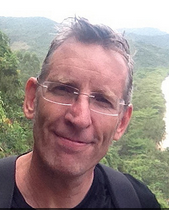
Jon Watts is the Guardian’s Latin America correspondent. (Photo: courtesy of Jonathan Watts)
WATTS: Logging’s not the only threat that is faced by the tribe. They see their identity, their culture being threatened by the steady encroachment on their territory and way of life of the outside world. So they have tried to resist this. They have insisted on having their own representative in the local government body that looks after indigenous people. When their children are taught in schools they are only taught in the Ka’apor language until the age of 10. That means that they have a very solid base in the local language; they have introduced or rather formalized their own calendar because they said the Gregorian calendar imposes seasons on them that make no sense for the way that they do that their planting and do their hunting and do their mating. And then the last way in which they’ve tried to resist the temptations of the outside world is to prohibit all alcohol inside the tribe. And what the Ka’apor say is, “well, we know the modern world, we know what modern technology is, we can use it, but we want to choose when we use it and that's how we maintain our sense of who we are”.
CURWOOD: Jonathan Watts is the Guardian’s Latin American correspondent, thanks so much for taking the time today Jon.
WATTS: It was a great pleasure. Thanks again.
Related links:
- The Amazon tribe protecting the forest with bows, arrows, GPS and camera traps
- Activists use GPS to track illegal loggers in Brazil’s Amazon rainforest
- Why are Brazil’s environmentalists being murdered?
- Dawn timber-laundering raids cast doubt on ‘sustainable’ Brazilian wood
- photoessay: “War in the Garden of Eden”
- Jon Watts’ environmental travelogue, When A Billion Chinese Jump
- Video: Fighting the Amazon’s Illegal Loggers
[MUSIC, Nazara Pereira/C.Nascimineto, Bonjour Par Voci, Ritmos da Amazonia, Playasound, 1988]
CURWOOD: Coming up, the voices of dolphins and their kin in the ocean --That's just ahead on Living on Earth. Stay tuned.
ANNOUNCER: Funding for Living on Earth comes from United Technologies, a provider to the aerospace and building systems industries worldwide. UTC Building & Industrial Systems, provides building technologies and supplies, container refrigeration systems that transport and preserve food, and medicine with brands such as Otis, Carrier, Chubb, Edwards and Kidde. This is PRI, Public Radio International.
[CUTAWAY MUSIC: Noah and the Whale, Instrumental 2, The First Day of Spring, Mercury 2009]
Humans and Dolphins
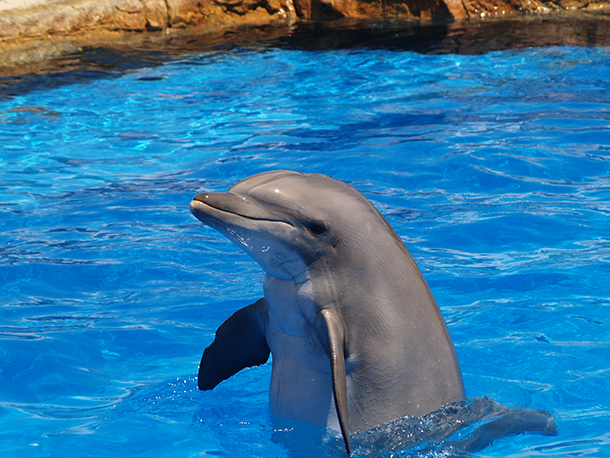
A dolphin has a brain that’s about 20% bigger than a human’s -- though, proportional to body mass, a dolphin brain is less than half as big as a human’s. (Photo: Bryce Bradford, Flickr CC BY-NC-ND 2.0)
CURWOOD: It’s Living on Earth, I'm Steve Curwood. Humans and dolphins have a long connection. Myth and literature abound with tales of dolphins rescuing hapless sailors and travelers washed overboard. And after Apollo hitched a ride on one round the south of Greece, they gave their name to his temple at Delphi. Dolphins routinely keep company with boats, they’ve been conscripted by the military, they’re held captive to perform in animal parks, and they’ve found a role in animal-assisted therapy. And writer Susan Casey set off on a quest that led to her new book, Voices in the Ocean: A Journey into the Wild and Haunting World of Dolphins, after a swim with them in the waters off Hawaii changed her life.
CASEY: You know, I was in a sort of grief-stricken depressed state of my life because I had lost my father suddenly, and I hadn’t been able to shake that sadness, and it was very interesting to me that after I had this swim with the wild dolphins of the coast of Maui something had lifted in me, there was like the sense of curiosity and joy crept back into my life and that was what I have been missing for almost 2 years. So then I started looking and that's when I realized just how much amazing science there was, how many amazing stories. This dolphin being used by treasure hunters to help them locate undersea treasure, the stories of dolphins being recruited by the U.S. Navy to serve as soldiers, and dolphins saving surfers from shark attacks, and it just went from there.
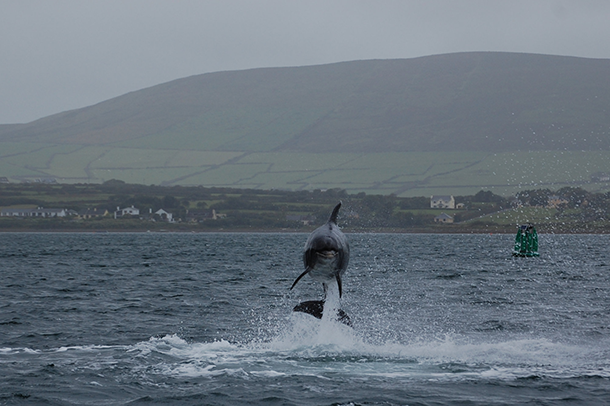
Fungie, a wild bottlenose dolphin who has made himself the centerpiece of the tourism industry in the town of Dingle, Ireland, has been named the “World’s Most Loyal Animal.” (Photo: Dulup, Flickr CC BY-SA 2.0)
CURWOOD: Well, let’s talk a little about the science of dolphins for a moment. What's really unusual about them as physical creatures?
CASEY: Well, one of the things that’s highly unusual about them is their evolutionary path. I mean, these are animals that began on land as a small-hoofed wolf, and that animal then went into the water around 55 million years ago and became a large sort of monstrous creature with big teeth and not a very big brain, and then around 35 million years ago there was another radical physiological change. They became smaller, they developed high-frequency hearing, their brains became much larger, they started to hunt cooperatively, and they became more or less the dolphins that we know today. So dolphins have done this incredible shape shifting, and along the way their brains have developed two hemispheres just like ours, but with completely different wiring. We arrived at the same spot, we’re both air-breathing mammals with large brains and high intelligence, but along completely different itineraries. And, to me, that was one of the most fascinating parts of the research, was how is the dolphin brain different than the human brain, what does that possibly mean about their abilities or cognition their social structures, and, you know, there's more than one way to be smart here on planet Earth and theirs is much more ancient than ours.
CURWOOD: Tell me about dolphin culture and society, and there’s a part of your book where you describe the different tribes, families, whatever, of Orcas that can be found off Seattle.
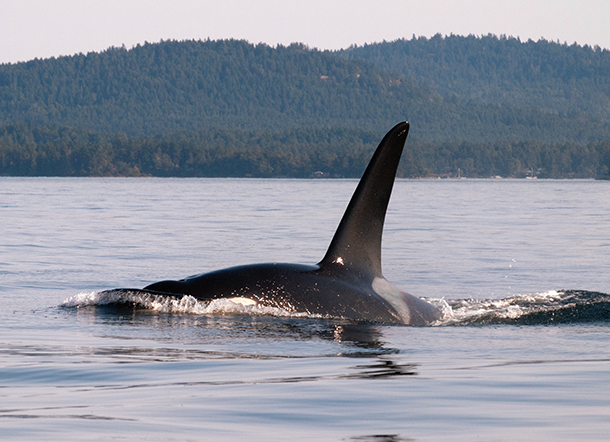
Orca in Puget Sound, near San Juan Island. (Photo: Ingrid Taylar, Flickr CC BY 2.0)
CASEY: Yeah, one of the most intriguing new directions for science about dolphins is that several scientists have come up with enough evidence that they feel confident saying that these dolphins live in societies and cultures that are not unlike ours. They are, of course, very different, but they have communities, they have families they learn socially like we do, so it fits the definition of cultural information being exchanged down through the generations. And these pods have their own dialects; scientists think that may be to protect against inbreeding, but it's clear that these animals have very distinct cultures throughout the world’s oceans.
CURWOOD: Alright, so tell me about the different ethnicities of orcas off Seattle.
CASEY: There're three different kinds of Orcas off the coast of Seattle. Scientists call them residents, transients and offshores and these three types of Orcas have about as much in common as investment bankers, rock stars, and nomadic herdsmen. The residents are the ones you see closer to shore. They hunt salmon, they have been seen in the company of transients, but the two types of Orcas don't really socialize, and at times there'll be scuffles. But when the residents meet other resident clans, occasionally they have this greeting ceremony that they do that’s very ritualized where the two pods will line up and face each other for a while, and then there's a lot of vocalization, a lot of contact, a lot of exuberant socializing, and they have these rituals sort of akin to the cultures that we have. The transients hunt marine mammals, seals and larger creatures like that, and then the offshore Orcas, which are the least known of those three types, seem to hunt sharks. So these three different cultures live in close proximity to one another but they don't have a lot to do with each other, and they have sort of split up their niche so that they're not at any one point depleting the food supply.
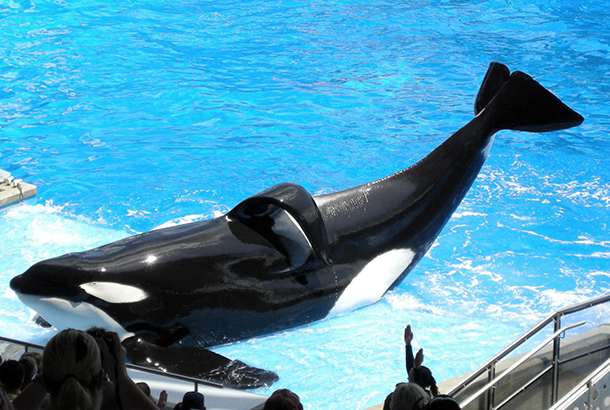
Casey says that while certain dolphin species are more adaptable to human interaction, orcas do poorly around people. (Photo: Milan Boers, Flickr CC BY 2.0)
CURWOOD: You write about John Lilly, a dolphin researcher whose studies became controversial. Tell me about him and some of his experiments.
CASEY: Well, I feel like I could write an entire book on John Lilly. He was a neuroscientist in the 50s and 60s, and he was very interested in knowing how the brain was structured, and, theoretically, if I could figure that out, if I could I poke a wire on this part of your brain and get you to do something accordingly. It's a really simplistic notion of how the brain works, but he happened to see a dolphin brain and just realized, like, here’s a big brain. He started work with bottlenose dolphins and was absolutely enraptured by the notion of this animal, and made these wild leaps into realms like, “well, they can communicate, so we could probably teach them to speak English, let's go do that” and in a sort of wonderfully audacious way got a bunch of money from various government agencies, got some land in the US Virgin Islands and created this sort of Xanadu of dolphin studies. And I love looking at pictures of it because you see Lilly standing there in this lab coat and there are the dolphins in these Mediterranean-style laboratory buildings and then there're always about 10 beautiful young women in bikinis, like it was this sort of Dr. No Dolphin Island. But things went from a little bit odd to quite bizarre rather quickly. Lilly began several experiments that would later be known as among some of the most ill-advised ever conducted in science.
CURWOOD: What kinds of things did he do - I gather at one point he had a woman living with a dolphin?
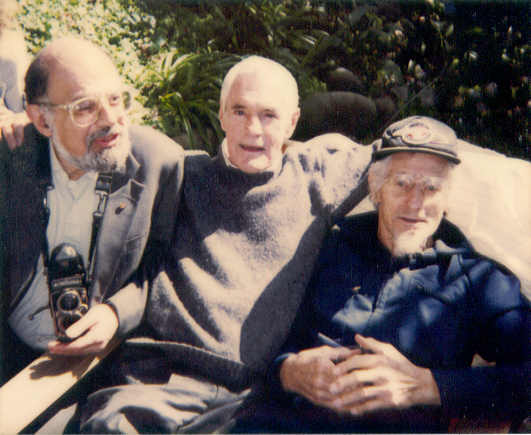
From left: Allen Ginsberg, Timothy Leary, and controversial dolphin researcher John C. Lilly, M.D. (Photo: Philip H. Bailey, Flickr CC BY-SA 2.5)
CASEY: Yeah I mean I think that's number one on the list of notorious experiments. The woman's name was Margaret Howe; she was a local woman from the US Virgin Islands and Lily wanted to see what would happen if you put a young dolphin in with a sort of a mother figure, a young female adult human, and flooded a house with twenty four inches of saltwater. Theoretically, the dolphin could swim in that and Margaret could slosh around in there. So they set out to live for 10 weeks in this house, the idea being that she would teach the dolphin how to speak English the same way that we teach our own children to speak English. But things went sideways very quickly. The dolphin was able to make noises and certainly mimic, but Margaret was coming apart because she could never get dry. She was around the clock with him, and he, to put it euphemistically, did not see her in a kind of parental role, he really saw her as a paramour and dolphins are highly sexualized. He began to follow her around making his desires very clear. And eventually Margaret decided that, well, the idea is to strengthen an interspecies bond here, let’s go for it. And she began to pleasure the dolphin, and I think at that point, when they published notes of that experiment, that’s when mainstream science really wrote Lilly off.
CURWOOD: It sounds pretty crazy.
CASEY: Yeah.
CURWOOD: How much sense does it make to confine dolphins and their relations in marine parks?
CASEY: Well,what you’re looking at in a marine park is a dolphin stripped of everything that makes him a dolphin—who’s not using his echolocation, who’s not with his closest compatriots, who’s not able to swim 60 or 70 miles a day in the ocean, who’s not hunting fish, he’s being served dead fish—and we know that they’re individuals. And we know they’re conscious of their surroundings, so what do we do with that knowledge? And that would be my question to anyone who feels, hey let’s go to a marine park, you know — knowing what you know, how do you defend doing that to a dolphin?
CURWOOD: Now, in Ireland there’s essentially a dolphin park where a dolphin entertains visitors except this particular dolphin is free to come and go. Tell me about him.
CASEY: Well, this is Fungie. Fungie lives in a bay in Dingle, Ireland. Fungie is famous. He’s been there for about 38 years. He was named the world’s most loyal animal. He basically is there all the time. The economy of the town completely depends on Fungie. About 5000 people a day come in the summer to see him and go out in the bay and it’s literally your money back if you don’t see him. He isn’t fed, he isn’t coerced in anyway to be there. And I was a little skeptical about this because I had heard about him but he seemed a little too good to be true, and I was wondering if he was the concoction of the Chamber of Commerce or something like that. And whether he was in some way trained or fed or maybe there was more than one dolphin and they were all Fungie, the same way there were a lot of Lassies. But I got there and almost immediately saw him and realized how distinctive he looks and how there’s absolutely no way they could ever swap in another dolphin. And so it was really curious to me, why does this particular dolphin choose to interact with humans, but as it happens he’s not completely unique. All over the world certain animals will break off from their groups and interact with humans, and scientists don’t know why this happens. They think maybe the dolphin at some point got lost and just decided to bond with humans. But usually this kind of relationship doesn’t end well for the dolphin because people end up coming far to close and in great numbers and it’s typical for them to get hit by propellers or jetskis. And Fungie’s more the exception than the rule, having lasted so long and being so well protected by the town.
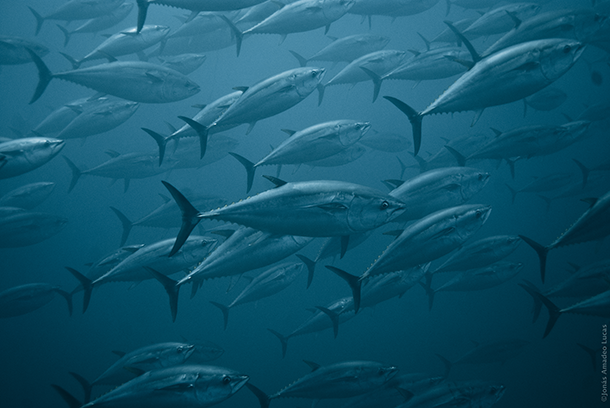
Where tuna are, dolphins often follow. This can end badly for the dolphins if they’re caught in fishing nets along with the tuna; but good fishing practices allow dolphins to swim free of the net. (Photo: TheAnimalDay.org, Flickr CC BY 2.0)
CURWOOD: Susan, how do you respond to the argument made by aquatic zoos, I’m thinking of SeaWorld, that giving public exposure to these animals helps to protect them over the long run.
CASEY: I mean I think that one of the scientists that I interviewed, Robin Baird, an amazing scientist, believes that seeing animals in aquariums and zoos really sparked his career choice, so I believe there is a value to that. But I think we can create environments that serve that function in a much better way if the intention really was education, as opposed to entertainment with a little bit of education thrown in. In Honduras, for example, there’s a place where some Bottlenosed Dolphins are given a little bit of food, but they’re not captives. They’ve chosen to be there in the same way as Fungie is. So I would like to see the conservation messages get real, the education messages get very science based. I look at the Monterey Bay Aquarium and they are just such a fabulous aquarium based on cutting edge science. There are no dolphins doing tail walking tricks and stuff like that, it’s not what its about. And then there are just some species that just don’t belong in captivity, Orcas are really at the top of that list.
CURWOOD: In your view how are we harming dolphins?
CASEY: Well, in several different ways they are up against it because of things we’re doing in the ocean. We’re overfishing in destructive ways that don’t allow for fish stocks to rebound or any sort of sustainable harvest of fish, so dolphins eat the same fish we do, and a lot of dolphins will end up tangled in long lines or with fishing hooks in their throats. And then of course you have the tuna fishing industry, which for the longest time was killing tremendous amounts of dolphins. Now we’re aware of that and Earth Island Institute has its dolphin-safe program globally which has helped. And then obviously the oceans are highly polluted. They are at the top of the food chain, they bioaccumulate things like mercury, other toxins, long-lived pollutants that still circulate in the oceans like PCBs, and dioxins, stuff we outlawed but its still there. And then the other problem is the noise in the oceans. The military sonar, which is incredibly loud. The prospecting for oil and gas that uses these airguns that literally explode underwater. All these things can deafen and even kill dolphins.

Susan Casey is also the author of the New York Times bestsellers The Wave and The Devil’s Teeth. (Photo: courtesy of Doubleday)
CURWOOD: From your own experience, your favorite dolphin?
CASEY: I think I became enchanted with false killer whales even though I haven’t seen them in the wild just from hearing this scientist Robin Baird talk about them. They are one of the largest species of dolphins. They are very engaged and engaging. They seem to be particularly curious about humans. They have a ritualized way of hunting where when they catch a fish they pass it around amongst each other and nobody takes a bite. So there’s a lot of intriguing things about false killer whales. Seeing one in the wild would be at the top of my list.
CURWOOD: Susan Casey is the author of Voices in the Ocean, and the New York Times bestsellers the Wave and the Devil’s Teeth. Susan thanks so much for taking the time today.
CASEY: Thank you.
Related links:
- “Voices in the Ocean” book
- The Dolphin Project
- NOAA Fisheries’ Protect Dolphins Campaign
- Pacific Northwest Orcas: distinct populations
- The dolphin who loved me: the NASA-funded project that went wrong
- About Fungie the Irish Dolphin
- 7 Marine Animals that are Not OK with Seismic Blasting
Black Lightning
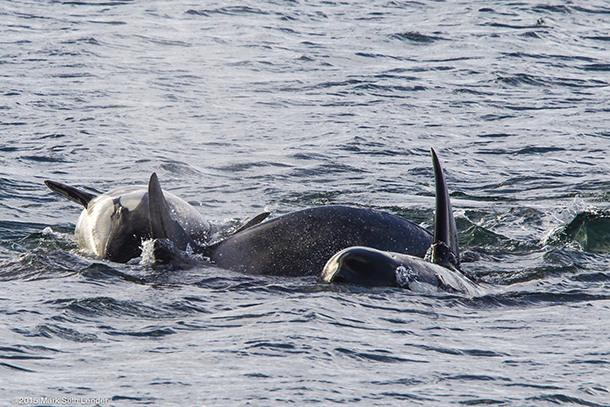
Orca Pod Bonding (Photo: Mark Seth Lender)
CURWOOD: As Susan Casey just told us, Orcas have cultures, cultures that prefer certain kinds of foods over others. And when it comes to the Icelandic Orcas, their favorite cuisine includes herring that move in great shoals in and out of the fjords of Iceland. Mark Seth Lender visited the fjords there as the orcas fattened up.
Orca Hunting Herring
© 2015 Mark Seth Lender
All Rights Reserved
Shadow at the speed of dark, Orca drives hard along the hull, wake within our spreading wake. The plimsol line upon his flank, muscular blade of dorsal fin, its ragged trailing edge, the bright white saddle before the eye. Elements, as unique as portraiture. He rolls to reveal that close-lipped Orca smile as he streaks by, a strike of black lightning; his glowing afterimage precedes the recognition of the eye.
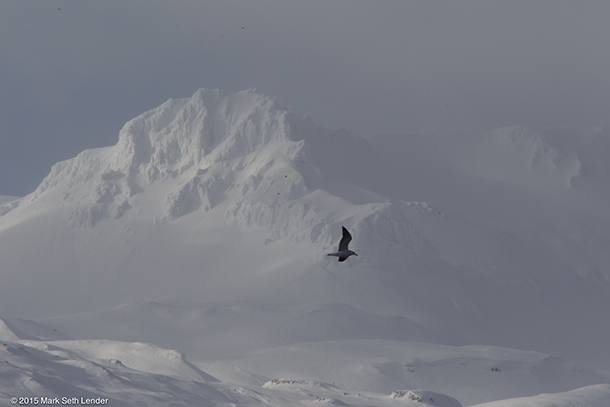
Whiteout at Kolgrafafjordur (Photo: Mark Seth Lender)
Veering away he vanishes into the turbulent water of Grundarfjordur.
Wind ploughs the sea.
The deck rolls.
The bow digs into the furrow on every plundering wave…
Sunrise.
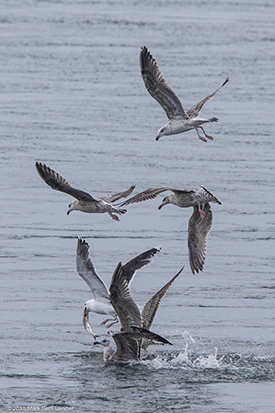
Gulls share in the Feast of Herring, Kolgrafafjordur (Photo: Mark Seth Lender)
To the East, beyond the promontory, Orca are hunting again. Beneath the steep white-coated mountains, between the deep walls at the head of the Kolgrafafjörður. Back, and forth, back and forth, each whale a hand-held scythe cutting and shearing, sounding and rising among the shoals of herring. A delicate threshing of the living grain, they take the fishes one by one.
The tide turns.
The herring run with the tide.
The harvest is ended.
At the narrowing mouth of the fjord a pod of Orca rounds and gathers. Bellies full, eyes crinkled like a joyous noise, their bodies bound together tight as a sailor’s knot, bound as if of single mind.
Unraveling, they drive north for open ocean…
Fingers of snow trace runes upon the fjord, erased as soon as they are born by the whiteout weather tumbling off the mountains.
Everyone that can, has gone. Behind the eyes the after-image fades and only Memory remains, a stiff brush scrubbed against the skin.

A Female approaches. (Photo: Mark Seth Lender)
Related links:
- Laki Tours, Grundarfjordu, Iceland
- Hotel Framnes and the Hotel Framnes Restaurant for accommodation
- Iceland Naturally for their guidance and generous support
CURWOOD: Writer Mark Seth Lender, and for some of his photos cruise on over to our website, LOE dot org.
[MUSIC: Breabach, Shoals of Herring, The Desperate Battle of the Birds, Breabach Records, 2010]
CURWOOD: Living on Earth is produced by the World Media Foundation and brought to you from the campus of the University of Massachusetts Boston, in association with its School for the Environment, developing the next generation of environmental leaders. Our crew includes Naomi Arenberg, Bobby Bascomb, Emmett Fitzgerald, Lauren Hinkel, Helen Palmer, Adelaide Chen, Jenni Doering, John Duff, and Jennifer Marquis. Tom Tiger engineered our show, with help From Jake Rego, Noel Flatt and Jeff Wade. Special thanks this week to the Allegheny Front, and WESA Pittsburgh, Iceland Naturally, and Laki Tours, Iceland. Alison Lirish Dean composed our themes. You can find us anytime at L-O-E Dot Org - and like us, please, on our Facebook page - it’s PRI’s Living On Earth. And we tweet From @Livingonearth. I'm Steve Curwood. Thanks for listening!
ANNOUNCER1: Funding for Living On Earth comes from the Grantham Foundation for the protection of the environment, supporting strategic communication and collaboration in solving the world’s most pressing environmental problems. Support also comes from the Kendeda Fund, and Trinity University Press, publisher of “Moral Ground” Ethical Action for a Planet in Peril 80 visionaries who agree with Pope Francis, climate change is a moral issue for each of us, T-U Press dot org , and Gilman Ordway for coverage of conservation and environmental change.
ANNOUNCER2: PRI. Public Radio International.
Living on Earth wants to hear from you!
Living on Earth
62 Calef Highway, Suite 212
Lee, NH 03861
Telephone: 617-287-4121
E-mail: comments@loe.org
Newsletter [Click here]
Donate to Living on Earth!
Living on Earth is an independent media program and relies entirely on contributions from listeners and institutions supporting public service. Please donate now to preserve an independent environmental voice.
NewsletterLiving on Earth offers a weekly delivery of the show's rundown to your mailbox. Sign up for our newsletter today!
 Sailors For The Sea: Be the change you want to sea.
Sailors For The Sea: Be the change you want to sea.
 The Grantham Foundation for the Protection of the Environment: Committed to protecting and improving the health of the global environment.
The Grantham Foundation for the Protection of the Environment: Committed to protecting and improving the health of the global environment.
 Contribute to Living on Earth and receive, as our gift to you, an archival print of one of Mark Seth Lender's extraordinary wildlife photographs. Follow the link to see Mark's current collection of photographs.
Contribute to Living on Earth and receive, as our gift to you, an archival print of one of Mark Seth Lender's extraordinary wildlife photographs. Follow the link to see Mark's current collection of photographs.
 Buy a signed copy of Mark Seth Lender's book Smeagull the Seagull & support Living on Earth
Buy a signed copy of Mark Seth Lender's book Smeagull the Seagull & support Living on Earth

